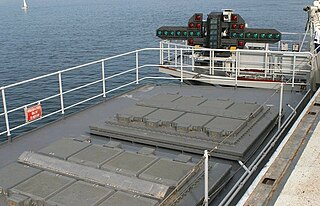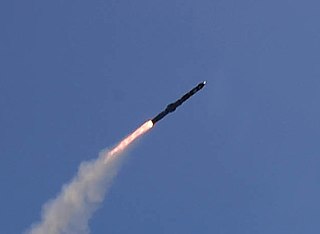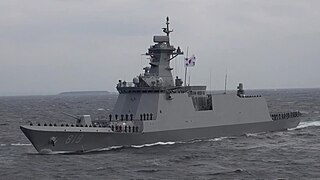
The Sylver is a vertical launching system (VLS) designed by DCNS and introduced in 2001.

A vertical launching system (VLS) is an advanced system for holding and firing missiles on mobile naval platforms, such as surface ships and submarines. Each vertical launch system consists of a number of cells, which can hold one or more missiles ready for firing. Typically, each cell can hold a number of different types of missiles, allowing the ship flexibility to load the best set for any given mission. Further, when new missiles are developed, they are typically fitted to the existing vertical launch systems of that nation, allowing existing ships to use new types of missiles without expensive rework. When the command is given, the missile flies straight up far enough to clear the cell and the ship, then turns onto the desired course.

The RUM-139 Vertical-Launch Anti-Submarine Rocket is an anti-submarine missile in the ASROC family, currently built by Lockheed Martin for the U.S. Navy.

The RIM-162 Evolved SeaSparrow Missile (ESSM) is a development of the RIM-7 Sea Sparrow missile used to protect ships from attacking missiles and aircraft. ESSM is designed to counter supersonic maneuvering anti-ship missiles. ESSM also has the ability to be "quad-packed" in the Mark 41 Vertical Launch System, allowing up to four ESSMs to be carried in a single cell.

The Sejong the Great-class destroyers, also known as KDX-III, are three guided-missile destroyers of the Republic of Korea Navy (ROKN).

The Hyunmoo-3 is a supersonic cruise missile fielded by the South Korean military designed by Agency for Defense Development (ADD). The name Hyunmoo comes from the mythical Black Tortoise described as the "Guardian of the Northern Sky", perhaps hinting North Korea.

The RIM-66 Standard MR (SM-1MR/SM-2MR) is a medium-range surface-to-air missile (SAM), with a secondary role as an anti-ship missile, developed for the United States Navy (USN). A member of the Standard Missile family of weapons, the SM-1 was developed as a replacement for the RIM-2 Terrier and RIM-24 Tartar that were deployed in the 1950s on a variety of USN ships. The RIM-67 Standard (SM-1ER/SM-2ER) is an extended range version of this missile with a solid rocket booster stage.

The Mark 41 vertical launching system is a shipborne missile canister launching system which provides a rapid-fire launch capability against hostile threats. The vertical launching system (VLS) concept was derived from work on the Aegis Combat System.

ROKS Daegu (FFG-818) is the lead ship of the Daegu-class frigate in the Republic of Korea Navy. She is named after the city, Daegu.

The Daegu-class frigate is a class of guided missile frigates of the Republic of Korea Navy (ROKN). The Daegu class is based on the preceding Incheon class, and has otherwise been referred to as the Incheon class batch II, or FFG-II. Eight Daegu-class ships have been commissioned, with the final goal of 20–22 frigates, of all types, in the ROKN. The Daegu-class frigates were built by Daewoo Shipbuilding & Marine Engineering (DSME) and Hyundai Heavy Industries.

The KSS-III, officially called Dosan Ahn Changho class is a series of diesel-electric multipurpose attack submarines currently being built for the Republic of Korea Navy (ROKN), jointly by Hanwha Ocean and HD Hyundai Heavy Industries (HHI). The KSS-III is the final phase of the Korean Attack Submarine program, a three-phased program to build 27 attack submarines for the ROKN, between 1994–2029.
GJB 5860-2006 is a Chinese military technical standard describing a vertical launching system (VLS) for all types of missiles aboard surface combatants.

ROKS Gyeongnam (FFG-819) is the second ship of the Daegu-class frigates in the Republic of Korea Navy. She is named after the place, Gyeongnam. The ship was launched in 2019 and commissioned in 2021.
ROKS Seoul (FFG-821) is the third ship of the Daegu-class frigate in the Republic of Korea Navy. She is named after the capital, Seoul.
ROKS Donghae (FFG-822) is the fourth ship of the Daegu-class frigate in the Republic of Korea Navy. She is named after the city, Donghae.
ROKS Daejeon (FFG-823) is the fifth ship of the Daegu-class frigate in the Republic of Korea Navy. She is named after the city, Daejeon.

ROKS Cheonan (FFG-826) is the seventh ship of the Daegu-class frigate in the Republic of Korea Navy. She is named after the city, Cheonan.

ROKS Pohang (FFG-825) is the sixth ship of the Daegu-class frigate in the Republic of Korea Navy. She is named after the city, Pohang.

ROKS Chuncheon (FFG-827) is the eighth and final ship of the Daegu-class frigate in the Republic of Korea Navy. She is named after the city, Chuncheon.












